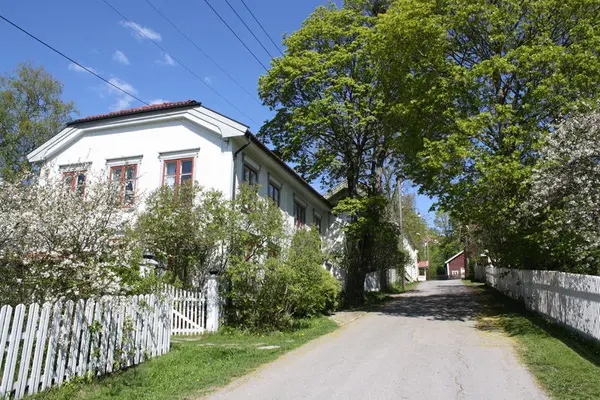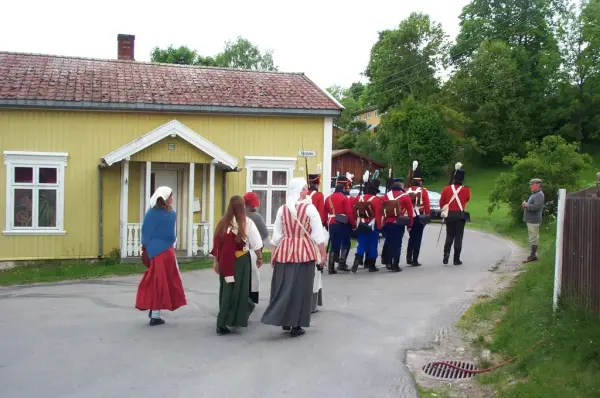- 1/1
Øvrebyen er vakker om våren Mona Holm | Kvinnemuseet, Anno
Right underneath the fortress walls, you find the old fortress camp and garrison town of Øvrebyen ("The Upper Town"). This oldest part of Kongsvinger consists of large officers' houses and smaller soldiers' quarters from the 18th and 19th Centuries. Here, you can also find the fine villas of the towns two privileged tradesmen. The building which housed he first hospital in the county of Hedmark can also be found here, together with one of the first inland pharmacies from 1836. You can find book printer Hess' old town house, where the county's first newspaper, Hedemarkens Amtstidende was published from 1846. Helene Hansens old boarding house is gone, but the house itself is still there, next to Glommendalen Gymnasium, today better known as Øvrebyen Videregående skole ("Øvrebyen Upper Secondary School") by the Church square.
Øvrebyen has many outhouse buildings. These were built as barns, stables, pigsties and chicken huts, and a lot of them were even built as privies, primitive outdoor toilets. Øvrebyen also holds a plethora of backyards as well as back alley cats. In the heart of Øvrebyen lies Herdahlshjørnet ("The Herdahl's Corner"). Here, Gerhard Munthe painted the view of the fortress when he spent his summer here in 1894. Today, creative women have opened new enterprises around this little park.
- 1/1
Soldater og marketentersker vandrer gjennom Leiret under festningen.
The upper part of Øvrebyen was built in the 18th Century. Further down, you find the 19th Century town, with the expansion which came as Kongsvinger was made a town in 1854. This is the childhood streets of Norwegian artist Erik Werenskiold. He grew up here, as his father was the commander of the fortress. Øvrebyen is also the childhood streets of the pianist Erika Nissen and her sister Thomasine Lie. They both lived at Svendborg, where the leader of Det Norske Jægerkorpset once ruled.
Øvrebyen has a real Jonas Lie-street. Thomasine Lie married her cousing Jonas, and they moved into the new house built by the tradesman Gjems in what was then called Kirkegaten. They lived here for nine years, up until 1868.
The Church square is the towns old, venerable meeting place and town square. This square held the market place from 1798, as well as drill ground from when Kongsvinger really was a garrison town with soldiers and cavalry.
High up over the rest of Øvrebyen lies the listed building Aamodtgården, an empire style building from 1801. It is now owned by Kongsvinger Museum, and you can visit the Dignitary's apartments, the former home of captain Harald Aamodt which is left as it was when he died in 1968. The old ballroom downstairs now houses the exhibitions of the Kongsvinger Art Society.
The town underneath the fortress has been under particular protection since 1975, as one of the first in Norway. It is to be conserved to protect its distinctive character.
Øvrebyen er et levende museumsområde. Om sommeren arrangeres ”Liv i leiren” med markedsboder, servering og underholdning og første søndag i advent er det "Julemarked". Har du lyst til å bli bedre kjent her? Hvorfor ikke bli med på en Øvrebyvandring
Øvrebyen is a living, breathing museum area. Every summer, it hosts "Liv i leiren" ("Camp Life") with markets, food stalls and entertainment, and every year, on the first Sunday of Advent, it hosts a Christmas market. If you wish to get to know this interesting bit of town better, there are city walks arranged every summer.

